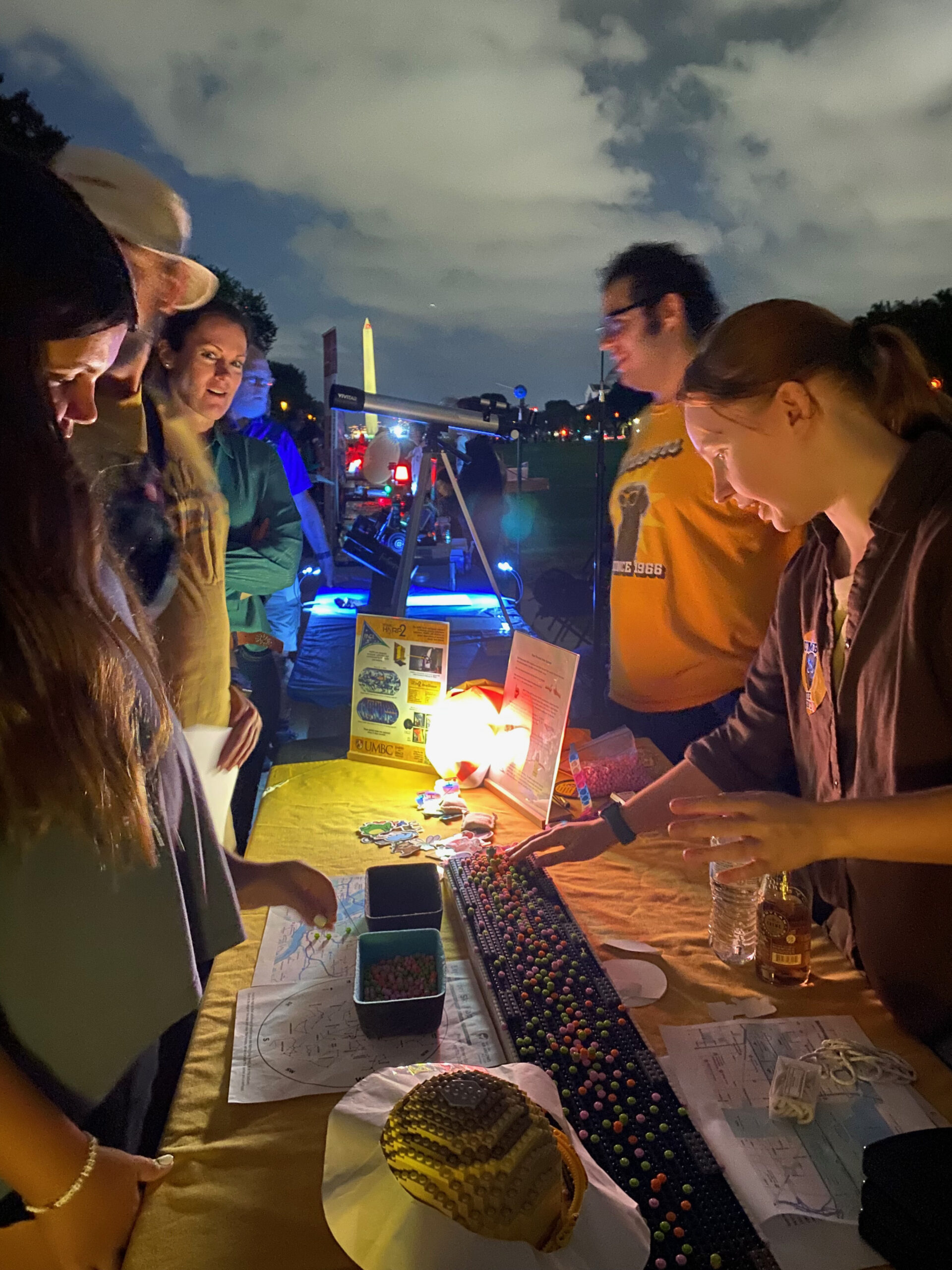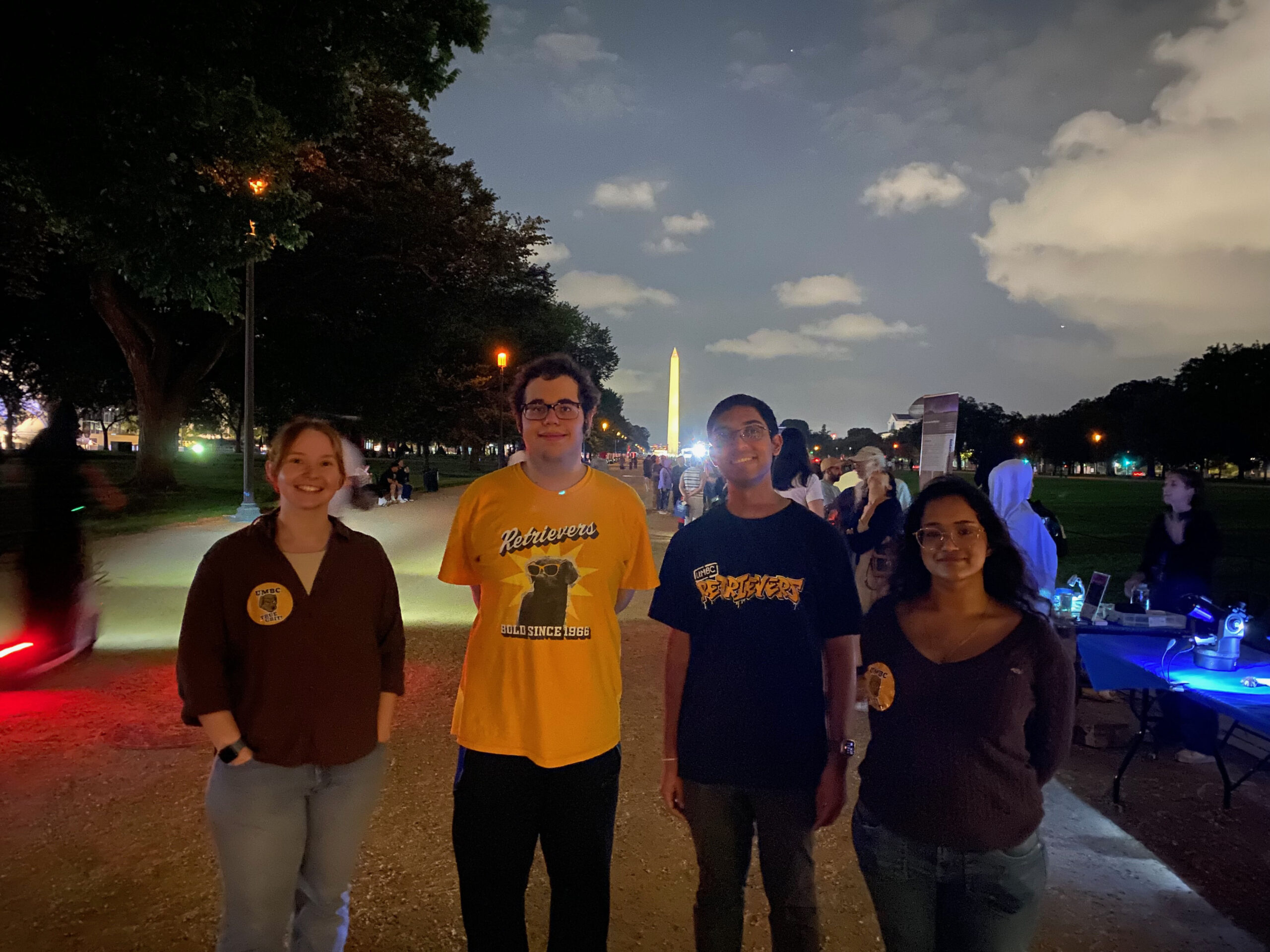UMBC Students Bring the Cosmos to the Capital at the Astronomy Festival on the National Mall
This past weekend, UMBC physics students joined NASA scientists, astronomy educators, and thousands of curious stargazers at the Astronomy Festival on the National Mall—an annual celebration of science that transforms America’s front yard into a field of telescopes, demos, and planetary imagination.
Representing UMBC were physics undergrads Shiney Kumar, Sam Wohl, and Sai Matukumalli, along with graduate student Dakota Wolf, who shared hands-on demos and thoughtful explanations with visitors of all ages. Sam even shared a laugh with Galileo himself (author’s note: unclear whether he was part of the official programming or just a very committed Renaissance enthusiast roaming the Mall). Shiney guided curious minds through the invisible universe with an infrared astronomy demo, inspired by the James Webb Space Telescope. Sai sparked conversations by challenging people to estimate the distance to the Moon, while Dakota offered an accessible and engaging explanation of the HARP2 instrument aboard the Earth observing PACE mission.
Also present was UMBC physics faculty member Dr. Daniel Gonzales, designer and builder of the now-legendary LEGO Solar System model, a perennial favorite at public outreach events. Built to scale (as much as LEGO bricks allow), the colorful and tactile model helped visitors grasp the sheer size of the planets and the vast distances between them. It drew plenty of questions—especially about how long it took to build Jupiter (answer: two years)—and fortunately, none of the inner planets were lost in the dark. Pluto wasn’t included. It’s used to the exclusion. The IAU is still accepting complaints.
Though the National Mall is arguably one of the worst places in America for actual stargazing, it’s one of the best places to share the wonders of the universe with the public. While it was difficult to see the stars through the light pollution, it was easy to see the spark of curiosity in every visitor. However, we did get lucky: a cloudy morning gave way to clear skies just in time for festival goers to view the Sun through solar telescopes, revealing sunspots and solar prominences in exquisite detail. As luck (and orbital mechanics) would have it, the Moon was in its new phase and nowhere to be seen. On the other hand, Saturn did make an appearance, and many visitors got to gaze at its iconic rings, just as Galileo did four centuries ago.
We spoke with hundreds of visitors: families, tourists, teachers, and students, all drawn in by curiosity, impressive telescopes, and of course LEGO Jupiter. Thanks to our student team for representing UMBC with such energy, warmth, and excitement. And thanks to everyone who stopped by to ask questions, share stories, or just whisper ‘cool’ for the tenth time in a row.
We’ll be back next year—with more LEGO, more enthusiasm (if that's even possible), and (hopefully) fewer clouds.


 Dakota Wolf, Sam Wohl, Sai Matukumalli, Shiney Kumar
Dakota Wolf, Sam Wohl, Sai Matukumalli, Shiney Kumar
Images credit: Dr. Dan Gonzales
Representing UMBC were physics undergrads Shiney Kumar, Sam Wohl, and Sai Matukumalli, along with graduate student Dakota Wolf, who shared hands-on demos and thoughtful explanations with visitors of all ages. Sam even shared a laugh with Galileo himself (author’s note: unclear whether he was part of the official programming or just a very committed Renaissance enthusiast roaming the Mall). Shiney guided curious minds through the invisible universe with an infrared astronomy demo, inspired by the James Webb Space Telescope. Sai sparked conversations by challenging people to estimate the distance to the Moon, while Dakota offered an accessible and engaging explanation of the HARP2 instrument aboard the Earth observing PACE mission.
Also present was UMBC physics faculty member Dr. Daniel Gonzales, designer and builder of the now-legendary LEGO Solar System model, a perennial favorite at public outreach events. Built to scale (as much as LEGO bricks allow), the colorful and tactile model helped visitors grasp the sheer size of the planets and the vast distances between them. It drew plenty of questions—especially about how long it took to build Jupiter (answer: two years)—and fortunately, none of the inner planets were lost in the dark. Pluto wasn’t included. It’s used to the exclusion. The IAU is still accepting complaints.
Though the National Mall is arguably one of the worst places in America for actual stargazing, it’s one of the best places to share the wonders of the universe with the public. While it was difficult to see the stars through the light pollution, it was easy to see the spark of curiosity in every visitor. However, we did get lucky: a cloudy morning gave way to clear skies just in time for festival goers to view the Sun through solar telescopes, revealing sunspots and solar prominences in exquisite detail. As luck (and orbital mechanics) would have it, the Moon was in its new phase and nowhere to be seen. On the other hand, Saturn did make an appearance, and many visitors got to gaze at its iconic rings, just as Galileo did four centuries ago.
We spoke with hundreds of visitors: families, tourists, teachers, and students, all drawn in by curiosity, impressive telescopes, and of course LEGO Jupiter. Thanks to our student team for representing UMBC with such energy, warmth, and excitement. And thanks to everyone who stopped by to ask questions, share stories, or just whisper ‘cool’ for the tenth time in a row.
We’ll be back next year—with more LEGO, more enthusiasm (if that's even possible), and (hopefully) fewer clouds.


 Dakota Wolf, Sam Wohl, Sai Matukumalli, Shiney Kumar
Dakota Wolf, Sam Wohl, Sai Matukumalli, Shiney KumarImages credit: Dr. Dan Gonzales
Posted: September 23, 2025, 2:21 PM
